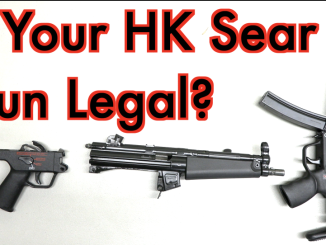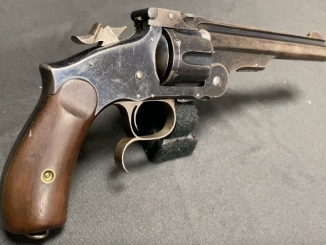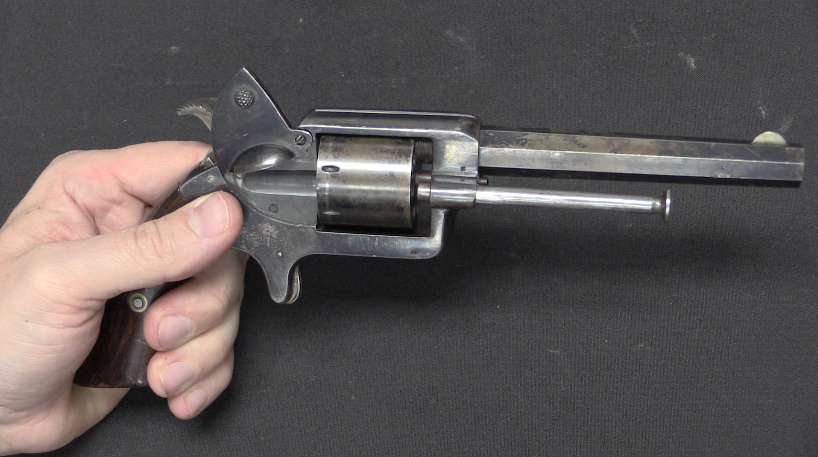The most well-known historic automatic revolver is the British Webley-Fosbery, but there were other handguns of the type that were put into production. One example is the Union auto-revolver, made in Toledo, Ohio shortly before the First World War. While the Webley-Fosbery was intended to be a high-quality military and competition gun, the Union Firearms Company intended to have their auto-revolver compete with inexpensive common revolvers. It was chambered for .32 S&W Short, with a 5-round cylinder and a shrouded hammer. Mechanically, it is very similar to the Webley, although simplified and clearly not made to the same standards of fit and finish. The design was patented by Charles Lefever – who you may recognize as the son of Daniel Lefever, who built Lefever shotguns (which were eventually taken over by the Ithaca Gun Company).
Only about 300 Union pistols were made before the effort was abandoned – the guns were much too expensive to manufacture to compete effectively in the chosen market. The retail advertised price for a Union was $10, when one could buy a new Iver Johnson, Hopkins & Allen, or similar traditional revolver for $3 – $6. For the Union’s $10 price, one could get a Colt/Browning Model 1906 semiauto, which was smaller, lights, more advanced, and much better made.
Union Firearms Reifgraber pistols:




I’ve wondered about these since seeing the ad in your Reifgraber video. Thanks, Ian!
Considering how awful the double-action trigger pull was on some of those cheaper revolvers, a self-cocking .32 might have felt pretty good and shot pretty straight in those days. Even the higher-end S & W lemon-squeezer takes some practice and hand strength to shoot accurately. Even modern revolvers can be a challenge: Former NYPD Assistant Commissioner Robert Daley, in his 1973 memoir “Target Blue,” recounts an incident of hostage-taking in an office. A detective disguised as a lawyer was sent to “negotiate,” then drew a gun and shot — and missed five of six shooting across a desk! One of the six fortunately incapacitated or killed the suspect. Daley added that the police inaccuracy rate at the time was something like 70% with revolvers and 30% with automatics.
“(…)how awful the double-action trigger pull was on some of those cheaper revolvers, a self-cocking .32 might have felt pretty good and shot pretty straight in those days”
But then question of quality of ammunition used in weapon destined for users of cheap revolver arises. In case of bit energy missing to cycle action of automatic revolver you have to fumble to reload is, in case of mentioned S&W Lemon-Squeezer just pull trigger again.
Agreed. While this is a fun FW curiosity, I think it combines most of the worst features of both revolvers and autos.
Well, that was discovered AFTER the fact. The intention was that one could shoot a revolver rapidly without nearly breaking his finger in the process and doing so only with his trigger hand (NO WILD WEST FAN-MOTIONS), all the while using FULL STRENGTH cartridges. Sound like what was intended?
Probably, but ammunition quality control back then wasn’t up to the job. Also consider that a good portion of .32 S&W ammunition at the time was being loaded with “Lesmok” semi-smokeless powder, which created more fouling than regular smokeless powder.
The combination would have done nothing good for this gadget.
cheers
eon
After the fact? So they couldn’t tell that it would have a five-shot capacity and a cylinder gap? Or that more moving parts / required mechanical functions meant more opportunities for jams?
Going through resumes
“This guy worked for Union”
Looks around table No words are said
Crumples up resme and throws it in the trash
My guess is that very few people realize what is behind “heavy trigger pull” at revolvers or double action pistols – it is primer sensitivity. There is a formula by which the primer sensitivity is determined and which is a prime concern of ammunition maker.
It is expressed as a field between two limits when 99% primers are initiated and 99% are NOT initiated. In other words amount of energy required to initiate vs. energy to almost never to initiate a primer. This is basically a function of firearm safety versus reliability more than anything else. It is a tough line to walk.
Do you want your DAO handgun/ revolver more safe OR easier to operate and/or more reliable? I do not fall either way and shoot my DA revolver in single action mode. If the shot does not come out, I go to the next and eject all when done. But, his is a range practice I talk about, not a self-defense use. If you plan to use it in defense, then you better practice that way.
A Spanish company named Zulaica made an automatic revolver in 25 ACP. I don’t know how many they made, but it was apparently offered for commercial sale, and not just a prototype. Zulaica was one of the many gunmakers in the Basque region of Spain before the Spanish Civil War. I have one of their Ruby type 32 automatics. Mine is in good condition, but it is otherwise a very ordinary example of the type.
PS – I posted this in the comments to this video on YouTube. I hope that is not considered spamming.
Hi Ian, I assume there isn’t any possibility of shooting the revolver to find out. I haven’t been able to find any video of anybody shooting one of those.